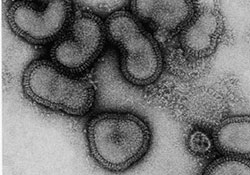Virology of human influenza

National Institute for Medical Research
Influenza virus
Human influenza viruses belong to the Orthomyxoviridae family, which consists of the genera influenza A, B, and C virus, thogotovirus (carried by ticks, and infecting humans), and isavirus (infecting fish), as well as of a few other, newly described arboviruses. Only influenza A and B viruses cause epidemics in human beings.
Based on their main antigenic determinants, the haemagglutinin (H or HA) and neuraminidase (N or NA) transmembrane glycoproteins, influenza A viruses are further subdivided into 18 H (H1–H18) and 11 N (N1–N11) subtypes. Influenza A subtypes and B viruses are further classified by strains. The nomenclature for influenza virus isolates includes the influenza virus type (A or B), host species (omitted if human in origin), geographical site, serial number, year of isolation and, lastly, the H and N variants in brackets.
An example of a human isolate is A/Brisbane/10/2007 (H3N2).
An example of an avian isolate is A/duck/Hunan/795/2002 (H5N1).
Genome and proteins
Influenza viruses have a single-stranded, negative-sense RNA genome and a pleiomorphic (non-uniform) envelope with a diameter of 50–120 nm. HA and NA glycoproteins form “spikes” that are spread over the surface of the viral particle. The influenza A and B virus genomes consist of 8 separate segments, each coding for 1 or several functionally important proteins required for virus entry, replication or virus structure.
HA binds to its cellular receptor, sialic acid (N-acetyl-neuraminic acid). The presence and location in the body of different types of sialic vary between humans, birds and other animals, which is a major reason for host specificity. The binding of HA to sialic acid induces penetration inside the cell by membrane fusion. Sialic-acid-presenting carbohydrates are present on several cell types, which is why influenza virus-producing cells can be found in the mucous layer of the respiratory tract, the gastrointestinal tract, endothelial layers, myocardium and brain. Influenza viruses have also been shown to cause viraemia (presence of virus in the blood).
The other surface glycoprotein of influenza viruses, NA, acts as an enzyme cleaving sialic acid from the HA molecule and facilitating release of the virus from the cell. NA is a target for antiviral drugs called neuraminidase inhibitors, such as oseltamivir and zanamivir. NA is also an important influenza virus antigen.
The M2 protein is required for efficient replication and is the target for antiviral drugs called adamantanes (amantadine and rimantadine,only for influenza A).
Replication and infectivity
The replication cycle of influenza viruses, from the time of entry to the production of new virus, is very quick, with shedding of the first influenza viruses from infected cells occurring after only 6 hours. Infectivity of influenza virus particles depends on temperature, pH and salinity of the water and ultraviolet irradiation. At 4 °C, the half-life of infectivity is about 2–3 weeks in water, although survival under normal environmental conditions is shorter. Avian influenza viruses survive in bird faeces and secretions for up to 4 weeks, depending on virus type, waste type, temperature and other environmental conditions.
Influenza viruses can be inactivated by disinfectants, such as those containing chlorine or hypochlorite, or alcohols, and destroyed by temperatures above 70 °C.



